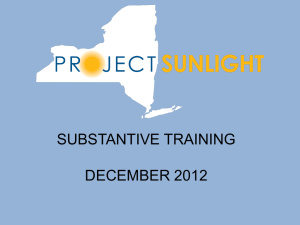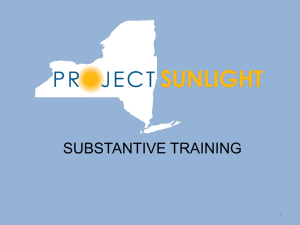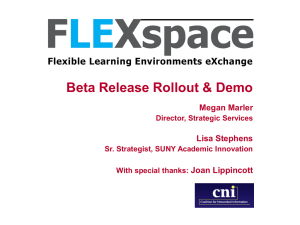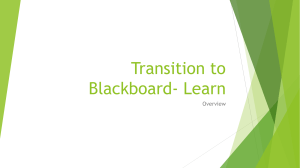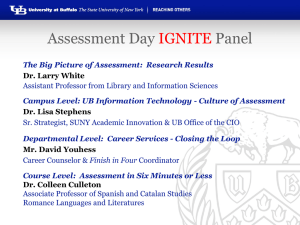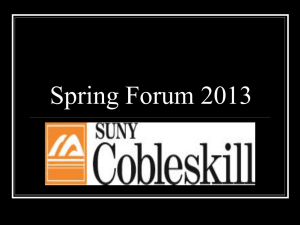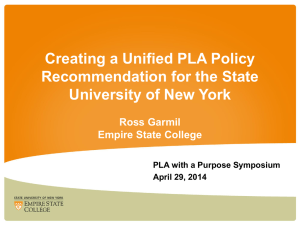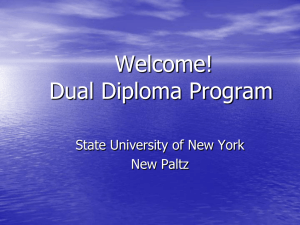Watch the Project Sunlight training video
advertisement
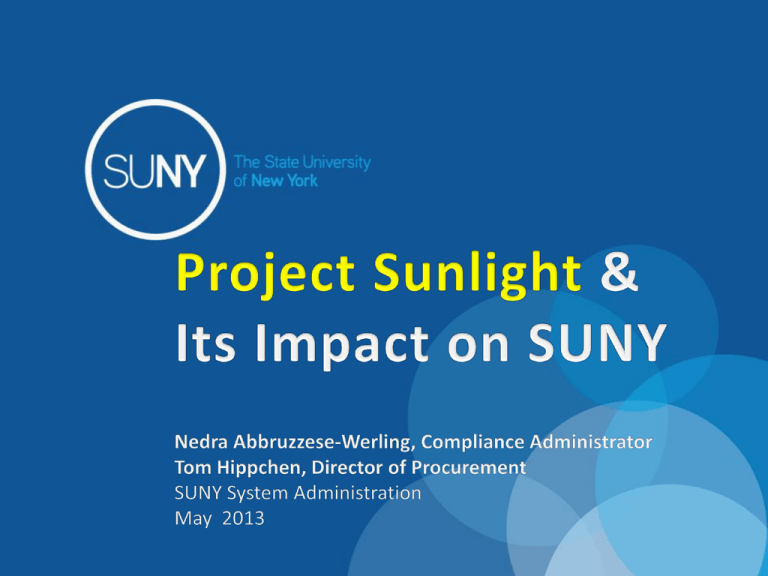
What is Project Sunlight A Component of the NYS Public Integrity Reform Act (PIRA) of 2011 • Became effective on January 1, 2013 • Law established a publicly accessible online database hosted by the Office of General Services (OGS) that provides the general public with an opportunity to see what entities and individuals are interacting with state decisionmakers prior to a formal contract What does Project Sunlight COVER • Covers every state agency, department, division, office and board (including SUNY & CUNY) • Covers every public benefit corporation, public authority, and commissions where at least one member is appointed by the governor What does Project Sunlight REQUIRE The law requires that SUNY employees who are decision makers or decision advisors report all substantive “appearances” with non-government entities (both individuals and firms) regarding one of five designated categories to an on-line searchable database within five days of the appearance IF the cost of the procurement / contract could be more than $25,000; All entries will be published on a public-facing website. What does Project Sunlight REQUIRE Only ‘appearances’ related to FIVE categories need to be reported to OGS: (1) Procurement of State contract for real property, goods, or services over $25,000 (2) rate-making, (3) regulatory matters, (4) judicial or quasi-judicial proceedings, and (5) rule-making per the State Administrative Procedures Category Most Likely to Affect SUNY: PROCUREMENT (1) Procurement of State contract for real property, goods, or services over $25,000 • SUNY decision makers and advisors must report appearances for the purpose of “procuring a state contract for real property, goods or services;” Includes: • • • • • When SUNY is purchasing/ going to purchase Where SUNY is entering into a revenue-generating contract Sale-of-land contracts involving SUNY land Facilities use contracts where SUNY is paid for use of space Any other potential STATE ‘contracts with a value over $25,000 Project Sunlight Appearances: WHAT must be reported You only report appearances related to the: • SPENDING OF STATE FUNDS or • PROCURING OF A STATE CONTRACT • If appearance is related to the spending of funds from a non-State fund account (i.e. Foundation, Auxiliary, or RF funds) = NOT REPORTED • If meeting to discuss a potential State contact (i.e. for the sale of SUNY land) or use of State-funded account = REPORT What Entities MUST report Appearances under Project Sunlight • State operated campuses • SUNY System Administration • Construction Fund • Charter Schools • Board of Trustees • Statutory Colleges What Entities DO NOT report Appearances under Project Sunlight • • • • RF Foundations Auxiliary Corps. Community Colleges Project Sunlight: WHO DOES NOT Report • Elected officials, executive or legislative employees or judges or employees of the judiciary • Inmates and parolees and their representatives before criminal justice state entities regarding their supervision and/or conditions of confinement • Representatives of the media • Persons under the age of 18 Project Sunlight: WHO DOES NOT Report • Medical practitioners at SUNY medical institutions (unless they are acting in the capacity as a SUNY Administrator) • SUNY Hospitals • SUNY Optometry • UB Dental School NOTE: This is an exemption specifically for SUNY Project Sunlight: WHEN to Report By Time Requirement: Appearances must be reported to the database within five (5) business days of the appearance, whenever feasible. Project Sunlight: What to Report Law only wants you to report Pre-Contract Appearances: Once contract is in place, reporting not required unless your meeting is ‘outside the scope’ of the existing contract Why: who SUNY/ State entities contract with is already made public Project Sunlight: What must be reported – How much $ Amount Threshold: Must ONLY report appearances that could result in purchase/ contract of $25,000 or more in goods and/or services • If you don’t know how much the value of the Procurement/ contract will be, you must err on the side of reporting • You DO NOT need to aggregate purchases in the absence of a contract What is a ‘Appearance’ Appearance: A substantive interaction that is meant to have an impact on the decision making process of a state entity. • Non-written communication: • In-person meeting OR • Video conference • Between State entity and an outside party: • Purely intra-State meetings do not need to be reported Project Sunlight Appearances: Interpretations of WHAT must be reported Substantive Interaction v. Ministerial: If the interaction between the SUNY representative and the vendor/advocate is purely informational, reporting is not required. Example: Individuals scheduling a meeting is considered ministerial Project Sunlight Appearances: Interpretations of WHAT must be reported Initiation: It does not matter WHO initiated the appearance. It must be reported whether SUNY or the outside party initiated. Formality and Location: The level of formality and the physical location of the meeting are irrelevant. Example: Vendor/advocate approaches you at the gym and tries to influence you regarding a procurement = Must report regardless of location / lack of formality/ initiation by vendor Project Sunlight Appearances: Interpretations of WHAT must be reported Single Matter Can Have Multiple Appearances: There can be multiple ‘appearances’ related to one single matter, and each appearance must be reported separately. Only One Report Per Meeting: If multiple ‘covered individuals’ (decision makers and advisors) attend a meeting together, only one report is necessary • Each meeting need only be entered into the Project Sunlight database once by one mandated reporter. Who is a Decision Maker or Decision Advisor under Project Sunlight? WHO Is a DECISION MAKER under PROJECT SUNLIGHT Campus decision-makers include, but are not limited to: Vice President for Administration Director of Procurement Purchasing Agent Athletics Director President Dean Vice President for Administration Chief Information Officer Provost Facilities Director WHO Is a DECISION MAKER under PROJECT SUNLIGHT WHO is a decision-maker or decision advisor: Campuses have different levels of employees who have the authority to make or influence procurement decisions such that they are Project Sunlight reporters • Determining the decision makers and advisors will depend upon the facts of a particular procurement and the purchasing structure at the campus Example: A Faculty member meets with microscope vendors to find the best microscope for their academic program needs, and advises the procurement employee which microscope to purchase Faculty member is a mandated Project Sunlight reporter in this fact scenario WHO Is a DECISION MAKER under PROJECT SUNLIGHT How should a campus decide/ evaluate WHO the decision-makers and decision advisor are: Campuses should evaluate their own administrative structure and err on the side of caution in deciding who to train in order to ensure that decision makers, decision advisors, and potential decision makers and advisors are aware of: • their personal reporting obligations under the law • the specific campus administrative protocol for how to report to the OGS database What appearances MUST be reported under Project Sunlight? Project Sunlight Appearances: WHAT MUST be reported Discretionary State Funds: REPORT • Appearances for the purpose of advocating for the receipt of discretionary state funds that have already been appropriated New Vendors for New Products, Service, Contracts: REPORT • Meetings with new vendors for products, goods and services, prior to a contract being in place Project Sunlight Appearances: WHAT MUST be reported Existing Vendors for New Products; New Services; New Contract: REPORT • Meetings with existing vendors for new products or services, or products and services outside the scope of the current contract agreement with vendor Contract Re-Negotiation: REPORT • Meetings involving substantial renegotiations of Contracts Project Sunlight Appearances: WHAT MUST be reported Appearances by Advocacy Organizations: REPORT • Meetings with organizations, unions, and other businesses that are advocating for another business are also considered appearances Example: Another higher education institution advocates for SUNY to use a vendor that they also use; this scenario constitutes a reported appearance What is NOT reported under Project Sunlight? Not Project Sunlight Appearances: NOT reported Written communication: NOT REPORTED • Faxes, letters, or emails are not appearances Phone Calls: NOT REPORTED • Phone calls are not appearances • ONLY in-person and video conference appearances are reported Under Threshold Amount: NOT REPORTED • Contacts related to procurements under $25,000 Not Project Sunlight Appearances: NOT reported Intra-State Communications: NOT REPORTED • Contact between SUNY and other state agencies; Includes appearances before: • other state and local agencies and authorities (including CUNY) • tribal governments • federal government representatives Not Project Sunlight Appearances: NOT reported Elected Officials: NOT REPORTED • Contact by elected officials, executive or legislative employees Legislation/ Budget Appearances: NOT REPORTED • Contact related to legislation or SUNY’s budget Philanthropy: NOT REPORTED • Gifts, donations, or grants to the State that are not in exchange for real property, goods, or services Not Project Sunlight Appearances: NOT reported Existing Contracts: NOT REPORTED • Appearances following the award of a contract related to contract administration; This includes: • Discussion of open contract terms • Purchases off an already existing contract • Meetings regarding contract performance Meetings with the Research Foundation: NOT REPORTED • Appearances in front of the Research Foundation because we have an existing contract with the RF to do business, generally, on SUNY’s behalf Not Project Sunlight Appearances: NOT reported Confidential Proceedings: NOT REPORTED • Any interaction that an agency or authority treats as confidential pursuant to any law, rule or regulation does not need to be reported. Note: Confidentiality requirements from federal & state statutes, rules or regulations always take precedence over reporting requirements of Project Sunlight. Not Project Sunlight Appearances: NOT reported Employee/Student Disciplinary Matters: NOT REPORTED • Employee and student disciplinary matters conducted in-house are not judicial or quasi-judicial proceedings (such that they would fall under one of the five categories outlined in the statute) and are also confidential personnel matters Not Project Sunlight Appearances: NOT reported Emergency Procurements: NOT REPORTED • Procurements related to emergencies, where emergency is defined the same as it is in the State finance laws. Agents of the State Entity: NOT REPORTED • Appearances between a covered individual at a state entity and an agent of the agency, such as a consultant Not Project Sunlight Appearances: NOT reported Non-Substantive Interaction: NOT REPORTED • Purely informational or ministerial contact Social Interaction: NOT REPORTED • Short and informal meet and greets, introductions, or purely social interactions Note: A social interaction can become a reportable appearance once the person tries to influence your decision related to a procurement or state contract Not Project Sunlight Appearances: NOT reported Determining Availability/ Market Research: NOT REPORTED • Outreach initiated by SUNY (state entity), where response is informational, where SUNY is: • determining interest or availability for an upcoming procurement, including inquiring about whether or not a company is an M/WBE, and whether they have the products or services needed, or • conducting market research, or • informing a policy decision NOTE: When initiated by the vendor/advocate, market research/ interest/ availability IS A REPORTABLE appearance Not Project Sunlight Appearances: NOT reported Industry Meetings, Conferences & Expos: NOT REPORTED • Participation in widely-attended industry meeting is not considered a an appearance • Practically, this means no reporting is required for: • professional conferences • expos/ visiting booths on a show floor/ exhibit hall • panels • training or educational programs • public auctions • where a vendor attends a SUNY Conference NOTE: reportable appearances can still happen before and after these widely attended events Not Project Sunlight Appearances: NOT reported Public Meetings: NOT REPORTED • Participation in meetings which are: • open to the public, or • subject to the Open Meetings Law, or • where a record of the meeting is otherwise available NOTE: communications outside of such public meetings but with respect to the same matter covered in the public meeting MUST be reported Not Project Sunlight Appearances: NOT reported RFP/ IFB Formal Procurement Processes: NOT REPORTED • Appearances as part of a formal procurement that are otherwise covered by the Procurement Lobbying Law, including : • meetings that occur during the restricted RFP or IFB processes • bid meetings and presentations • meetings with designated contacts • bid clarifications NOTE: The reason these formal procurement processes are excluded from reporting is because there are existing protocols that restrict communication to a designated contact during this time period Not Project Sunlight Appearances: NOT reported Meetings that Raise Safety Concerns to the parties involved: NOT REPORTED •Any appearance that, if disclosed and published on the public-facing website, could endanger the life or safety of any person, or could subject an individual to a risk of retaliation or adverse employment action What does Project Sunlight mean to you as a SUNY Decisionmaker or advisor? Must REPORT Information to OGS Database • Find out the process for reporting appearances on your campus • CENTRALIZED APPROACH: Some campuses have DESIGNATED employees who access the OGS database and input all Project Sunlight Appearances for the campus • DECENTRALIZED APPROACH: Some campuses are having the decision makers and advisors access the database and input their own appearances directly What Information Must be Reported to OGS • Date of Appearance (month, day, year) • Type of Meeting: In-Person Video Conference • Location of Appearance: BUILDING, STREET, CITY, STATE, ZIP • Purpose of Meeting: (one of the 5 categories listed in the law) PROCURING, RATE MAKING, REGULATORY MATTERS, JUDICIAL, ADOPTION OF A RULE • Name of SUNY Contact and Affiliation: SUNY SYS ADMIN, SUCF, CAMPUS What Information Must be Reported to OGS • Name of Company at Appearance • Company Location: CITY, ZIP ONLY (IF LARGE COMPANY, LOCATION THAT REP. WORKS OUT OF) • Outside Representative at Appearance: (E.G., COMPANY’S ATTORNEY, LOBBYIST) • Outside Representative’s Location: CITY, ZIP ONLY (IF LARGE COMPANY, LOCATION THAT REP. WORKS OUT OF) • Name of Non-SUNY Contacts Project Sunlight Hypotheticals Project Sunlight Hypotheticals: WHEN TO REPORT – WHEN NOT TO REPORT Note: With the following hypotheticals, assume the following: • The appearance is in-person and • The value of the purchase/ contract is over the $25,000 threshold Project Sunlight Hypotheticals: WHEN TO REPORT – WHEN NOT TO REPORT 1. Appearances before Current vendors with existing contracts? No No because the vendor already has a contract with SUNY, and so ‘appearances’ related to that contract are not reported EXCEPT if the appearance discussion is outside the scope of the existing contract, then it would constitute a reported appearance Project Sunlight Hypotheticals: WHEN TO REPORT – WHEN NOT TO REPORT 2. A bidders conference occurs during the RFP process. Is this reportable? No No because appearances are not reportable if they during the Restricted Period of the RFP Process. However, an appearance prior to the commencement of the Restricted Period that is a substantive attempt to influence a SUNY decisionmaker to purchase a vendor’s product, even if unsolicited, IS a reportable appearance. Project Sunlight Hypotheticals: WHEN TO REPORT – WHEN NOT TO REPORT 3. Another University/ Union/ Association is advocating for you to procure or contract with a particular vendor? Yes The law states that we must report appearances where people are acting in a representative capacity, such that this advocacy is reportable Project Sunlight Hypotheticals: WHEN TO REPORT – WHEN NOT TO REPORT 4. Meeting related to the sale of SUNY land? YES The appearance is related to a potential state contract, so it is reported, even if SUNY is selling its on property Remember: Project Sunlight covers procurements, where SUNY is purchasing, but also revenue-generating contracts, where SUNY is being paid for land/ use of facilities/ services Project Sunlight Hypotheticals: WHEN TO REPORT – WHEN NOT TO REPORT 5. Meeting to purchase a software program for the System, where RF funds would be used? NO Appearances related to the spending of non-state funds are not reported Project Sunlight Hypotheticals: WHEN TO REPORT – WHEN NOT TO REPORT 6. Meeting to purchase a software program for the System, where CF funds would be used? YES Remember that the Construction Fund, as a public benefit corporation, is included for purposes of reporting under Project Sunlight, so an appearance related to the spending of Construction Fund’s own funds MUST be reported Project Sunlight Recap How will Project Sunlight Impact SUNY Compliance Mandate: SUNY employees who are decision makers or decision advisors report substantive “appearances” with non-government entities (both individuals and firms) regarding one of five designated categories to an OGS on-line searchable database within five days of the appearance if cost of the potential procurement / contract could be more than $25,000. How will Project Sunlight Impact SUNY Remember: • Only pre-contract ‘appearances’ need to be reported • Only in-person and video conference ‘appearances’ need to be reported • Only ‘appearances’ that could result in contracts/ procurements with a value over $25,000 need to be reported Required SUNY Action Each Campus and Operational Center MUST: 1. Designate one/several individuals responsible for entering data in the OGS Project Sunlight database • See the SUNY Project Sunlight Compliance website for instructions on how to access the database 2. Decide who is a decision maker or decision advisor, and ensure those employees undergo Project Sunlight training • Retain records of WHO has been trained at your campus, and ensure re-training every other year Required SUNY Action Each Campus and Operational Center MUST: 3. Develop procedures to assure SUNY individuals before whom outside individuals and firms make reportable appearances complete the OGS form or convey notice of the appearance to the SUNY individual responsible for entering data in the OGS database Project Sunlight Resources All Project Sunlight Information can be found on the SUNY Compliance Website [www.suny.edu/compliance] • TOPICS: Project Sunlight • Forms • Training Materials • Other Resources Questions: submit to projectsunlight@SUNY.edu Specific legal questions: SUNY Legal Counsel Office (518) 320-1400 or your campus counsel directly New York State Website: http://projectsunlight.ny.gov/ Thank you!
